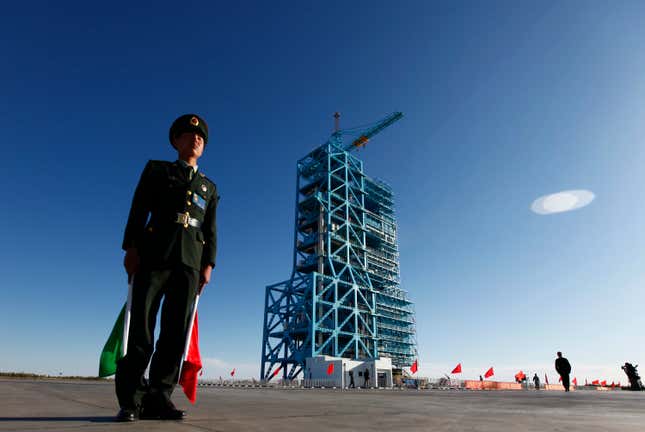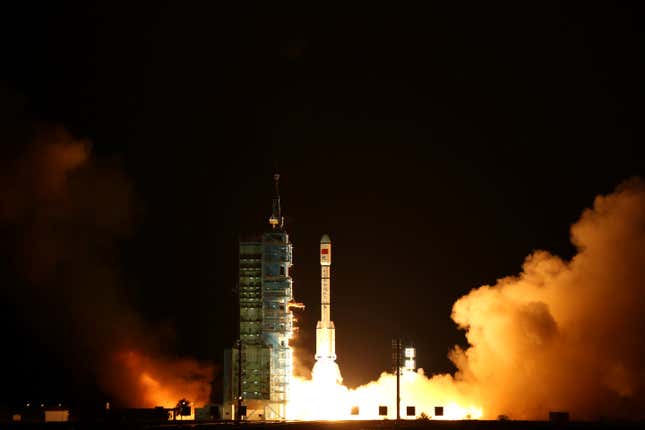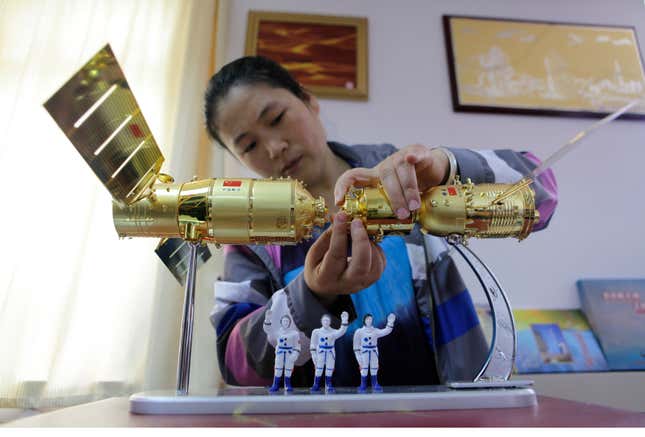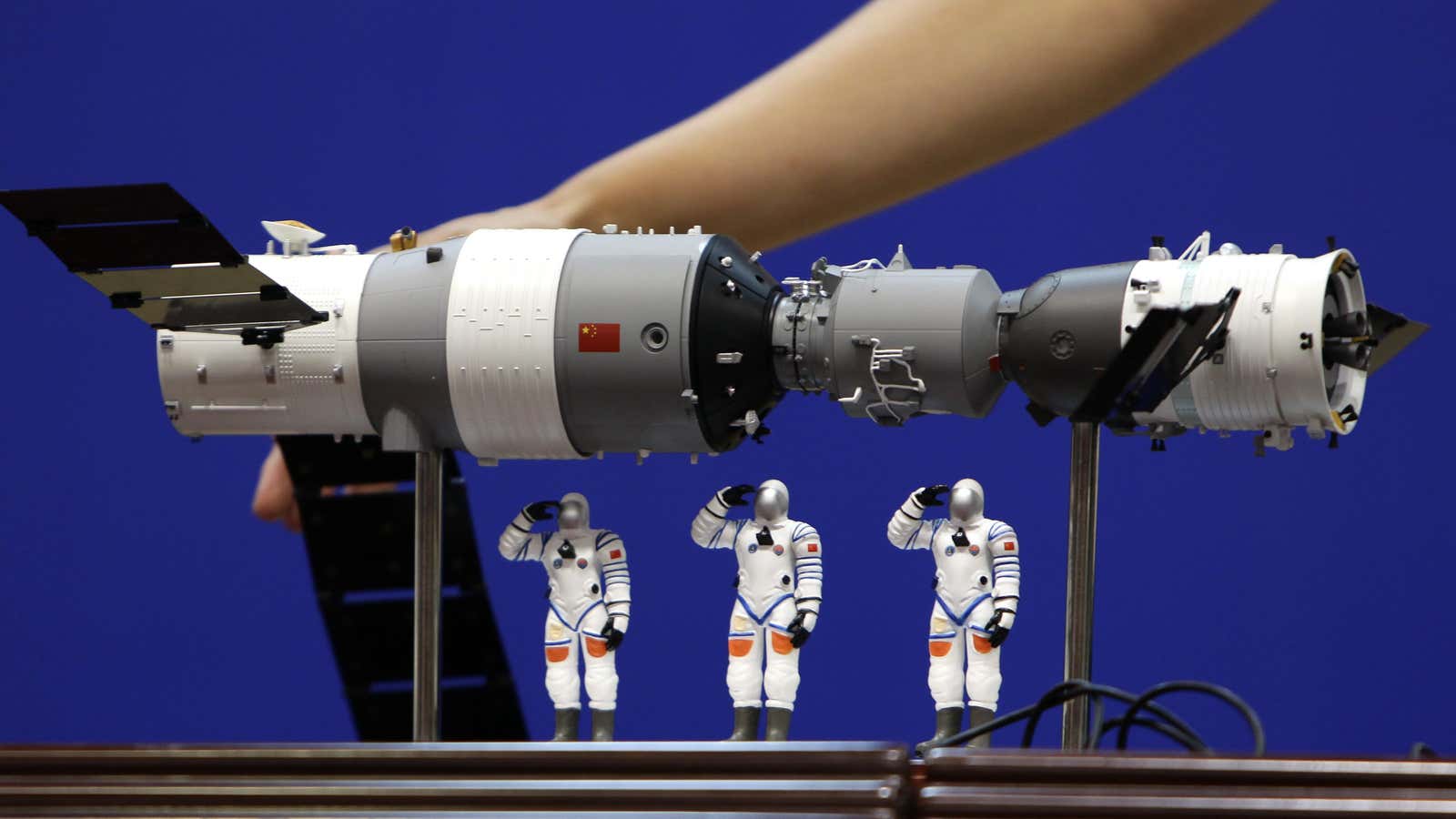Update, April 2: The Tiangong-1 re-entered earth’s atmosphere Monday morning Beijing time and burned up somewhere over the South Pacific, China’s space agency said.
China’s first space lab Tiangong-1 is coming back to Earth soon, in pieces. Its re-entry, expected in a matter of days, has been highly anticipated.
Launched from the windswept Gobi desert in 2011, the lab represented China’s determination to catch up to—and one day outpace—global powers on every playing field. Shut out of the International Space Station over security concerns, Tiangong-1 was a major step on China’s journey to having its own space station one day.
Less than a decade since its launch, China is already one of the world’s leading space explorers, with ambitious plans to land on the uncharted far side of the moon, and to conduct a Mars mission in 2020.
A prototype for China’s future space station
On Sept. 29, 2011, nearly 10,000 local herdsmen and farmers, and tourists, gathered the night of the launch at an observational point in China’s far northern region of Inner Mongolia, state broadcaster China National Radio reported (link in Chinese). When a bright spot, similar to a star in size, showed up in the skies, some of the watchers cheered and yelled: Long live the motherland.
The launch of the Tiangong-1, also known as Heavenly Palace, a popular way to refer to unexplored space (link in Chinese), offered the rush of national pride a Russian kid might have experienced at the time of the launch of the Sputnik-1 in 1957, or Americans felt watching astronaut Neil Armstrong step on the moon in 1969.

To celebrate the launch, students from an aeronautics university in the eastern city of Nanjing gathered to wave small Chinese flags, and even created a burning logo made of two Chinese characters,Yu Tian (御天), which means conquering the sky. On Weibo, China’s Twitter-esque social media platform, there were more than half a million (link in Chinese) posts and comments to celebrate the achievement.
The launch came the same year that the US Congress barred any cooperation between the National Aeronautics and Space Administration (NASA) and China, citing security concerns. That left China unable to use the International Space Station (ISS) because the US space agency is one of the station’s operating parties. (Meanwhile, the US and Russia had been collaborating for years on the ISS, despite their historical enmity.)
For China, the Tiangong-1 was a key step toward the permanent space station it hopes to put into operation in 2022, from where it would be able to send spacecraft to conduct research elsewhere in our solar system.
Inside the Heavenly Palace
The Tiangong-1 lab was not, it must be said, palatial. The lab is only one-10th the length of the ISS, which is about as long as a football field. It’s more comparable to Salyut-1, the first space station launched by the Soviet Union in 1971, according to Jonathan McDowell, an astrophysicist at Harvard University.
But inside, it’s quite roomy and well-equipped. The lab was a “long cylindrical box shape with small straps installed at points all along the four walls for the astronauts to hold weightlessness,” described Brian Harvey, in his book China in Space: The Great Leap Forward. There were three computer screens for astronauts to work on, and one more that displayed the Chinese flag, in addition to a toilet and a food heater, he wrote. It was also the ultimate picnic location: while previous space travelers relied on biscuits and toothpaste-tube food, said Harvey, the first team to visit the Chinese lab had more than 70 different food items with them, such as bean curd, rice, and fried dishes.
Two months into the launch of Tiangong-1, China completed the first unmanned docking with the lab. Then in June 2012, astronauts on the Shenzhou-9 completed the country’s first manned spacecraft rendezvous and manual docking with the lab, something that both the US and Soviet Union achieved in the 1960s.
During the only two crewed visits to the space station, the lab also hosted China’s first two female cosmonauts, Liu Yang and Wang Yaping. During her stay, Wang delivered China’s first lecture from space, using objects like spinning tops and water to explain physics in zero gravity.
An uncontrolled return journey
Designed with a two-year lifespan, the lab has not been visited by a crew since late June 2013. It was supposed to retire back then and make a controlled re-entry, but, according to McDowell, China was worried it wouldn’t be able to get the lab’s successor into orbit. (The Tiangong-2 was launched in September 2016.)
During its extended operations period, the lab conducted experiments on remote sensing and the space environment, before ceasing to function in March 2016, according to China’s Manned Space Engineering Office, effectively becoming a piece of space junk. Later that year the agency predicted the lab would fall to Earth in late 2017. Many interpreted this as confirmation the lab had fallen out of the space agency’s control. Some amateur satellite trackers suggest the lab has been that way since at least 2016, according to the Aerospace Corporation, a federally funded space-research organization. In May 2017, China told the United Nations the lab would land between October that year and April 2018 (pdf).
At its launch, the lab was designed to orbit at the height of 343 kilometers (213 miles), noted Harvey in his book. Currently orbiting at an average height of 216 km (134 miles), it’s descending about an average of two kilometers per day, according to the latest trajectory data (link in Chinese) from China.

It’s not uncommon for spacecraft and satellite, or parts of them, to reenter the atmosphere. By one estimate, an average of 200 to 400 space objects re-enter the atmosphere every year. Russia’s Mir space station made a controlled re-entry in 2001. Having an uncontrolled re-entry, in Tiangong-1’s case, isn’t considered the best practice. A controlled re-entry uses the space object’s engines to propel it on a safer path, for example over the ocean.
The European Space Agency says the lab could fall somewhere between the latitudes of 43ºN and 43ºS, an area largely covered by the ocean but that also includes countries like the US, Brazil, Spain, and China itself. Scientists may only be able to figure where parts are landing a day or a few hours before the actual re-entry, according to the ESA. This is because, the Economist explains (paywall), the Earth’s outer atmosphere exerts a drag on anything orbiting under about 2,000 km (1,243 miles), meaning the object will fall out of orbit without regular boosts. The drag is not constant, though, which can speed up or slow down the process of orbital decay.
“When an object is uncontrolled, and its orbit is decaying, it starts tumbling,” Lisa Rand, a space junk scholar and a postdoctoral fellow at the University of Wisconsin’s Madison campus, told Quartz. The lab is subject to friction and pressure in the earth’s upper atmosphere and it will start to break apart, according to Rand.
China space agency said most of the lab would burn up during the fall, but there’s still a chance—rather a tiny one—for someone to be hit by the lab’s debris. It’s only believed to have happened once—in 1997 to a woman named Lottie Williams as she was strolling through a park in Tulsa, Oklahoma. She wasn’t injured.
The other danger lies in the surviving fragments, because they could potentially contain a highly toxic and corrosive substance, noted the Aerospace Corporation.
A new era for China’s space dreams
China spends some $3 billion every year on its space budget by one estimate. That’s around 14% of the nearly $21 billion the US allocated to NASA for the 2018 fiscal year. Even so, in 2016, China launched 22 rockets—the same as the US—and for the first time surpassed the 17 launched by Russia.
In the area of space science alone, which includes planetary body exploration and satellite development, Chinese scientists have asked the government to triple the total investment from 2011 to 2015 to at least 15.6 billion yuan ($2.6 billion) for 2026 to 2030, according to a recent proposal from China’s National Space Science Center, a key state-backed institute in developing satellites. That would bring China far closer to NASA’s budget for the same area of about $5.9 billion (pdf, p.2).
“China could overtake America in spaceflight if these trends continue,” Morris Jones, an Australian space analyst, wrote in an email to Quartz.

This year, China will launch a relay satellite station some 60,000 km behind the moon used to set up communications between earth and the lunar far side in June. It will then fly the Chang’e-4 lander and rover spacecraft to the far side of the moon in December. Landing on the far side of the moon has never been tried before, though the Soviet Union sketched out a similar mission in the late 1970s, author Harvey told Quartz in an email.
The scientific gains could be huge—the probe could give China first-hand information and insights into the moon’s formation (pdf, p. 14) including its interior structure. No one else so far has planned to carry out a similar project, according to Jones.
The country is also looking at a Mars probe in 2020, when NASA and the ESA are planning to launch their rovers to collect samples from the planet’s surface. China’s project, consisting of an orbiter, lander and rover, will be China’s first interplanetary mission, and aims to explore the planet’s surface for three months. The probe would carry 13 payloads including a remote-sensing camera and ground-penetrating radar.
“China still has a long way to go before it exceeds the US in space overall. But it will soon be pretty much an equal,” said Harvard astrophysicist McDowell.
